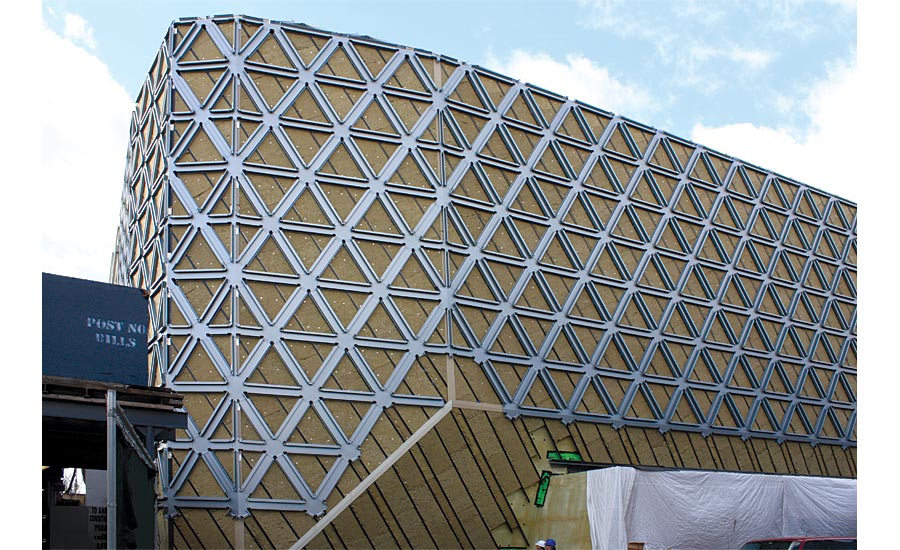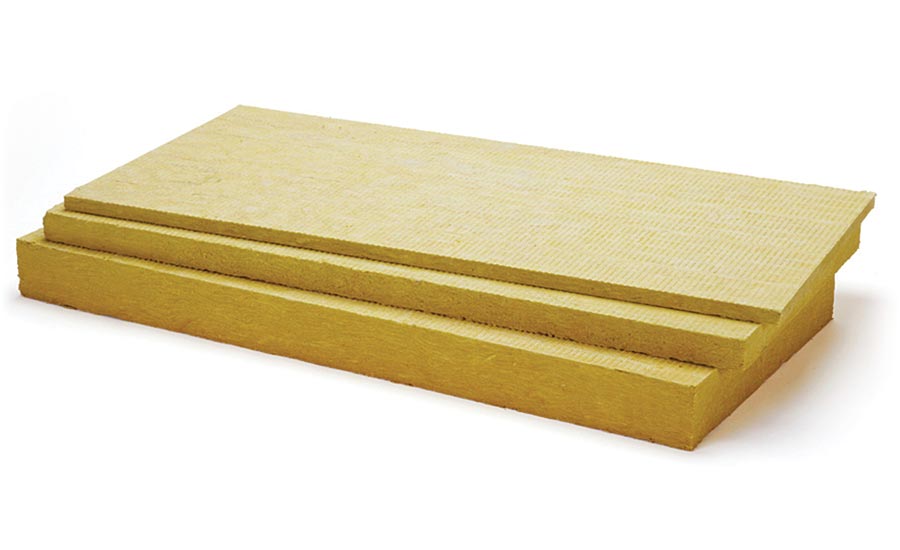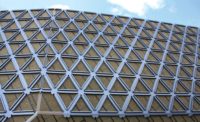In commercial building design, weight and strength were traditionally viewed as one-and-the-same, especially when it came to choosing continuous insulation. A denser, heavier material was viewed as the optimal choice for heavy claddings like masonry, while specifiers sought out lighter options for new cladding materials like plastics and laminates. This mindset created some myths in the marketplace—myths that it’s time to debunk.
As a new decade gets underway, it’s time to clear up misconceptions and illuminate the possibilities and performance that arise when we separate strength from compressive weight. The weight of a mineral wool is not an accurate indicator of its compressive strength.
Today, newer ci manufacturing processes and building science advances are introducing interesting possibilities, such as the ability to deliver higher compressive strength with lighter weight mineral wool. Below we discuss why it’s important to think in terms of strength versus weight when evaluating continuous insulation options.
Separating Weight From Strength
Specifiers traditionally have relied on material weight and/or density as the primary indicator of strength. The heavier the material, the more compressive strength it was assumed to have.
Compressive strength is always a key consideration when specifying ci. The ci must be strong enough to reduce risks of deflection and resist loads from cladding and wind washing. While weight and compressive strength are indeed correlated somewhat in foam plastic and mineral wool ci, new research and advances in mineral wool manufacturing are making this relationship less direct. Mineral wool ci can now be produced that is relatively light and has high compressive strength, enabling more flexible design options.

New Manufacturing Methods, New Research
Mineral wool insulation is made by spinning molten rock or slag into fibers which are bound together to create insulating material. Mineral wool isn’t a new material—its manufacture in the U.S. dates to the 1930s—but it has received renewed attention in commercial building in recent years because of its fire safety profile (mineral wool doesn’t burn) and sustainability characteristics, including the fact that it’s made from recycled materials and features high R-values.
How mineral wool is made—and how that process can contribute to compressive strength—has also gotten a fresh look. The Building Science team at Owens Corning has developed patent-pending technology that optimizes binder content and the orientation of fibers in mineral wool insulation batts. These advances enable a high level of control over the strength and thermal profile of the company’s mineral wool ci products.
The mineral wool options produced using these new techniques weighs 25 percent less but in testing, actually demonstrates higher compressive strength than heavier insulation. Across a large building project, this weight savings could significantly reduce stress on the exterior wall components and could require less material for attachment systems. Lighter insulation is also easier to handle during transport and on the job site. The result could be lower material and labor costs.
More than strength
Beyond lighter weight that maintains compressive strength, mineral wool delivers several other important performance benefits. While these characteristics are often attractive for interior insulation options, they can also add value in ci applications.
Thermal performance
Mineral wool provides an R-value of up to 4.3 per inch per ASTM C518, Standard Test Method for Steady-State Thermal Transmission Properties by Means of the Heat Flow Meter Apparatus. Mineral wool is an excellent choice to mitigate thermal bridging.
Moisture resistance
In tests that simulate use in exterior wall cavities, mineral wool has been shown to absorb only 0.03 percent moisture by volume. If mineral wool does get wet, its original thermal properties return when it dries out.
Fire resistance
Mineral wool is fire resistant to temperatures above 2,000 degrees Fahrenheit (1,093 degrees Celsius) and helps prevent the spread of fire and smoke. Mineral wool can be a key contributor to fire-safe assemblies that enhance building and occupant safety.
Acoustics
At as little as 38 millimeter thickness (1.5 in), mineral wool has been shown to be “perfectly absorptive” of sound per ASTM C423, Standard Test Method for Sound Absorption and Sound Absorption Coefficients by the Reverberation Room Method (at frequencies over 1000 hertz).
Air leakage resistance
Mineral wool can be installed using various hanging systems without compromising the integrity of the air and water barrier.
Vapor permeability
Mineral wool lets moisture vapor escape the wall cavity and will not trap liquid moisture in the wall cavity.
Sustainability
Mineral wool comprises up to 75 percent recycled contents, contributing to green building practices.

When is Mineral Wool the Right Choice for CI?
Choice of ci material has to be considered in context of cladding, building design and structural stressors, such as wind-washing. In many cases, rigid foam products continue to be a reasonable and economic choice. Mineral wool should be considered for ci, however, when a lower mass or combustible cladding material is preferred. Mineral wool can be used not only with brick, metal, stone, masonry, terra cotta and concrete but also with metal panels, high pressure laminate, and aluminum composite materials. With its low weight/high compressive strength, it can also be a good choice for architectural cladding options like phenolic panels and high-pressure laminates. It’s particularly useful in projects with uneven surfaces, where it may be difficult for rigid foam products to achieve a completely tight fit.
Designers of New York’s Museum of the Moving Image specified mineral wool ci for many of these reasons. The building’s striking, minimalist design uses an open joint system with mineral wool installed behind the cladding. The mineral wool ci not only stands up to the everyday stresses of the building and its environment, it withstood three seasons’-worth of variable jobsite conditions during the project’s nine-month construction process. In this case, the mineral wool proved a robust ci option before it was even installed.
When it comes to selecting ci for your next project, don’t rely on weight alone as an indicator of strength. Lighter-weight mineral wool could provide the compressive strength your project needs, while delivering additional benefits in thermal performance, sustainability, fire safety and more. In many cases, the benefits of mineral wool can far outweigh your typical ci options.







Report Abusive Comment